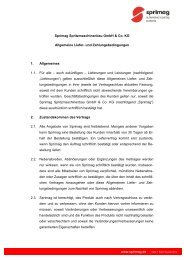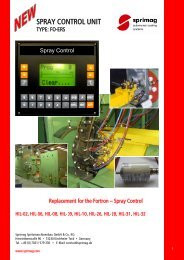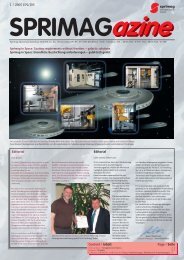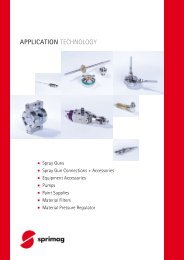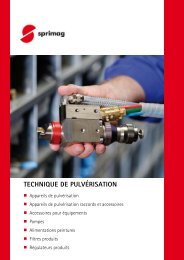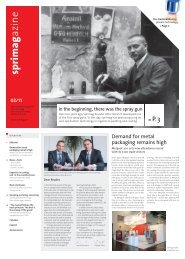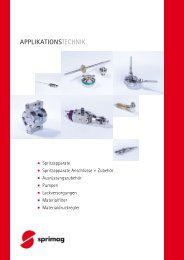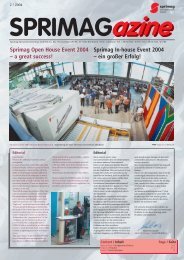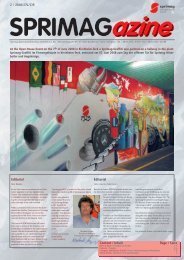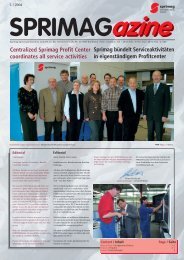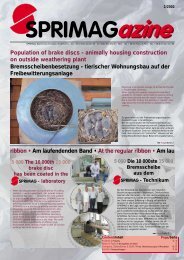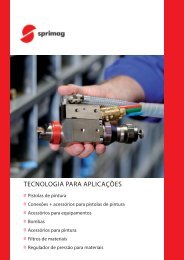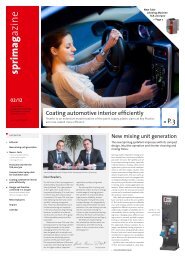Ich weiß, dass ich nichts weiß (Sokrates) ...aber ich weiß ... - Sprimag
Ich weiß, dass ich nichts weiß (Sokrates) ...aber ich weiß ... - Sprimag
Ich weiß, dass ich nichts weiß (Sokrates) ...aber ich weiß ... - Sprimag
Erfolgreiche ePaper selbst erstellen
Machen Sie aus Ihren PDF Publikationen ein blätterbares Flipbook mit unserer einzigartigen Google optimierten e-Paper Software.
6<br />
Innovations in our laboratory:<br />
Hydro nozzle to process<br />
water-based paint<br />
The application of water-based paints is<br />
becoming more and more important in<br />
the coating industry. Especially, driven by<br />
the imminent introduction in 2007 of the<br />
new VOC directives with their requirements<br />
to significantly reduce the emissions of<br />
organic solvents. By the changeover to<br />
water-based paints, quick and sustainable<br />
Nozzle set „Hydro“ / Düsensatz „Hydro“<br />
improvements in the solvent balances in<br />
paint shops may be achieved. Therefore,<br />
<strong>Sprimag</strong> is very active in offering to its<br />
customers optimized process solutions for<br />
the easy introduction of these new paint<br />
applications.<br />
In general, the characteristics of waterbased<br />
paints due to their compositions are<br />
significantly different to those of conventional<br />
solvent-based paints. Applications<br />
that had been optimized for solvent-based<br />
paints can rarely be changed over to<br />
water-based paints without making any<br />
alterations, as this will tend to lead to<br />
enormous losses in the quality of coating.<br />
For instance, water-based paints tend to<br />
generate water droplets; hence more<br />
evaporation energy is required than in<br />
comparison to solvent-based paints. It<br />
should also be taken into consideration<br />
that these paints are more sensitive with<br />
respect to the surrounding’s relative humidity<br />
and for the most part, show a worse<br />
wetting ability because of polarization.<br />
These are only a few of the problems paint<br />
shops are faced with when processing<br />
modern paints.With an extensive knowhow<br />
about the application of water-based<br />
paints by automated machines, <strong>Sprimag</strong> is<br />
in a unique position to support its customers<br />
during the changeover to water-based<br />
paint applications. Often, our laboratory<br />
accompanies the start of a project.<br />
Competent staff members are on customer's<br />
side acting as consultants, and if<br />
necessary, carrying out extensive trials for<br />
pilot projects. In many cases precise practical<br />
ways of tackling a problem create new<br />
solutions, for instance the <strong>Sprimag</strong> „hydro<br />
nozzle“. With this nozzle, (patent applied<br />
for), difficult to handle water-based paints,<br />
can be applied reliably onto various substrates.<br />
Because of its special design, it<br />
greatly reduces clogging of the nozzle.<br />
Compatibility of this nozzle to our standard<br />
spray gun S 333 grants economical<br />
access or change over to this technology.<br />
Many <strong>Sprimag</strong> customers already success-<br />
fully use the „hydro nozzle“. In serial production,<br />
intervals of more than 8 hours<br />
may be reached before it is necessary to<br />
clean, this new nozzle.<br />
Also <strong>Sprimag</strong>'s 2K-Mixing Plants are already<br />
optimized for the continuous use of waterbased<br />
paints. High quality, corrosion-resistant<br />
components in connection to process<br />
orientated technical knowledge result in a<br />
machine design that reliably delivers high<br />
quality coating results under real production<br />
conditions using these “difficult paint”.<br />
Positive reactions of our customers working<br />
with water-based paints on <strong>Sprimag</strong><br />
machines are the proof of the extensive<br />
development efforts by <strong>Sprimag</strong> in this<br />
field. They also confirm that when properly<br />
applied, water-based paints nearly match<br />
the coating quality of solvent-based paints.<br />
please contact:<br />
hans-peter.boeckeler@sprimag.de<br />
Neuheit aus dem Technikum:<br />
Hydrodüse zum Verarbeiten<br />
von Wasserlacken<br />
Bei industriellen Lackverarbeitern gewinnt<br />
die Verwendung von Wasserlacken in<br />
Lackierautomaten seit einiger Zeit sehr<br />
stark an Bedeutung. Insbesondere die VOC-<br />
Verordnung und deren Anforderungen zur<br />
Senkung der Lösemittelemissionen stellt<br />
dabei eine treibende Kraft dar. Durch die<br />
Umstellung auf Wasserlack können hier<br />
rasch und nachhaltig verbesserte Lösemittelbilanzen<br />
in den Lackierbetrieben<br />
erzielt werden. Deshalb ist <strong>Sprimag</strong> sehr<br />
daran interessiert, ihren Kunden mit optimierten<br />
verfahrenstechnischen Lösungen<br />
Projects<br />
das Applizieren dieser Lacke zu erle<strong>ich</strong>tern.<br />
Allen Wasserlacken ist gemeinsam, <strong>dass</strong> sie<br />
durch ihre stark veränderte Zusammensetzung<br />
ganz andere Verarbeitungseigenschaften<br />
aufweisen, als herkömml<strong>ich</strong>e<br />
Lösemittellacke. Die bisher erfolgre<strong>ich</strong><br />
eingeführten Verfahrensprozesse können<br />
deshalb n<strong>ich</strong>t ohne weiteres übernommen<br />
werden. Sie hätten sehr starke Qualitätseinbußen<br />
bei den Besch<strong>ich</strong>tungsergebnissen<br />
zur Folge. Beispielsweise neigen Wasserlacke<br />
eher zur Läuferbildung, weil sie gegenüber<br />
Lösemittellacken eine höhere Verdunstungsenergie<br />
benötigen. Ihre höhere<br />
Empfindl<strong>ich</strong>keit bezügl<strong>ich</strong> der umgebenden<br />
relativen Luftfeuchtigkeit und eine<br />
meist schlechtere Benetzungsfähigkeit<br />
aufgrund der Polarisation sind bei der<br />
Verarbeitung zu beachten. Dies sind nur<br />
einige Probleme, denen s<strong>ich</strong> der Lackverarbeiter<br />
beim Einsatz dieser modernen<br />
Lacke gegenübersieht.<br />
<strong>Sprimag</strong> kann ihren Kunden bei der Umstellung<br />
auf Wasserlackapplikationen<br />
durch umfassendes Know-how bei der<br />
Verarbeitung dieser Lacke in automatisierten<br />
Anlagen unterstützen. Oftmals beginnt<br />
der Projekteinstieg über das <strong>Sprimag</strong>-<br />
Technikum. Kompetente Mitarbeiter stehen<br />
hier dem Kunden beratend zur Seite<br />
und führen bei Bedarf aussagekräftige<br />
Pilotversuche durch. Konkrete praktische<br />
Problemstellungen initiieren dabei häufig<br />
neue Lösungen, wie z. B. die <strong>Sprimag</strong><br />
„Hydrodüse“. Mit dieser zum Patent angemeldeten<br />
Düse können auch sehr schwierig<br />
zu verarbeitende Wasserlacke, prozesss<strong>ich</strong>er<br />
auf die verschiedensten Substrate<br />
gebracht werden. Durch ihre besondere<br />
Konstruktion ist die Gefahr der Verstopfung<br />
der Düse stark reduziert. Die<br />
Kompatibilität der Düse zum Standard-<br />
Spritzapparat S333 gewährleistet einen<br />
wirtschaftl<strong>ich</strong>er Ein- bzw. Umstieg in diese<br />
Technik. Die „Hydrodüse“<br />
wird seit geraumer<br />
Zeit erfolgre<strong>ich</strong><br />
von <strong>Sprimag</strong>-Kunden<br />
eingesetzt. Mit ihr<br />
werden in der SerienproduktionEinsatzintervalle<br />
von über<br />
acht Stunden erre<strong>ich</strong>t,<br />
bevor eine Reinigung<br />
der Düsen notwendig<br />
wird. Ebenso sind die<br />
2K-Mischanlagen von<br />
<strong>Sprimag</strong> für den<br />
Dauereinsatz von<br />
Wasserlacken ausgelegt.<br />
Hochwertige,<br />
korrosionsbeständige<br />
Komponenten in<br />
Verbindung mit verfahrenstechnischem<br />
Wissen führten hier zu einem Anlagenkonzept,<br />
das auch „problematische“ Lacksysteme<br />
unter Produktionsbedingungen<br />
zuverlässig für einen hochwertigen Besch<strong>ich</strong>tungsauftrag<br />
konditionieren.<br />
Die positiven Reaktionen unserer Kunden<br />
beim Applizieren von Wasserlacken auf<br />
<strong>Sprimag</strong>-Anlagen rechtfertigen die Entwicklungsanstrengungen<br />
von <strong>Sprimag</strong> in<br />
diesem Bere<strong>ich</strong>. Sie zeigen auch, <strong>dass</strong> bei<br />
einer qualifizierten Auswahl der Anlagentechnik<br />
mit Lacken auf Wasserbasis<br />
Lackierergebnisse erzielt werden können,<br />
die den Besch<strong>ich</strong>tungen mit Lösemittellack<br />
mindestens ebenbürtig sind.<br />
Kontakt:<br />
hans-peter.boeckeler@sprimag.de<br />
New Round Table Unit at<br />
<strong>Sprimag</strong> Brasil<br />
The Brazilian subsidiary of <strong>Sprimag</strong> in São<br />
Paolo has evolved into a well-established<br />
paint shop, meeting the highest requirements<br />
of quality and output. Most of the<br />
parts are coated on a Chain-on-Edge type<br />
Lacquering Machine, wh<strong>ich</strong> is designed for<br />
high capacities. Due this, it does not easily<br />
lend itself to trials or experimentation.<br />
A machine more suitable for this task is a<br />
Round Table Machine RA 1150/08. The<br />
coating application is similar to that of the<br />
Chain-on-Edge Machine, (spraying whilst<br />
the part is rotated), but the cycle times are<br />
considerably shorter and the parts are<br />
more accessible. Therefore, results may be<br />
quickly created and evaluated.<br />
Furthermore, high flexibility and usability<br />
are central characteristics of this compact<br />
machine. Beside trials, this machine is also<br />
used for the manufacturing of small batches.<br />
This machine is optimized for the coating<br />
Spray station / Spritzstelle<br />
of plastic parts, though it is equally suited<br />
for the coating of virtually any material.<br />
8 spindles are mounted on a round table<br />
with a diameter of 1150 mm. The table's<br />
indexing may be infinitely adjusted up to a<br />
maximum of once every 6 seconds, (the<br />
table itself is capable of indexing faster, it<br />
is the coating process that defines the<br />
maximum speed). The table is equipped<br />
with a centrally mounted vertical servo<br />
driven spray axis. Mounted on this axis are<br />
6 spray guns, 3 each for two spray positions.<br />
Thus, up to 20 spindles per minute may be<br />
coated. Parts with a rotation diameter of<br />
up to 420 mm and a height of up 500 mm<br />
may be loaded on each consecutive spindle.<br />
Parts with a larger diameter may be<br />
accommodated on every second spindle.<br />
Loading and unloading of parts is carried<br />
out manually. Once a part is loaded, the<br />
operator releases the round table, wh<strong>ich</strong><br />
indexes the spindles around by one position<br />
into the direction of the spray station.<br />
The spindles are equipped with sealed<br />
lubricates for life ball races, and are capable<br />
of carrying up to 10 kg.<br />
In front of the spray station, the spindles<br />
are optically scanned to determine<br />
whether they are loaded or not. Empty<br />
spindles pass through the spray positions<br />
unsprayed. Spindles are set into rotation<br />
near the spray positions by a friction drive<br />
with adjustable rotation speed. Exhaust air<br />
is sucked off via a water wash-out spray<br />
booth, located behind the spray station.<br />
The function of the radial fan is continuously<br />
monitored and may be run indepen



